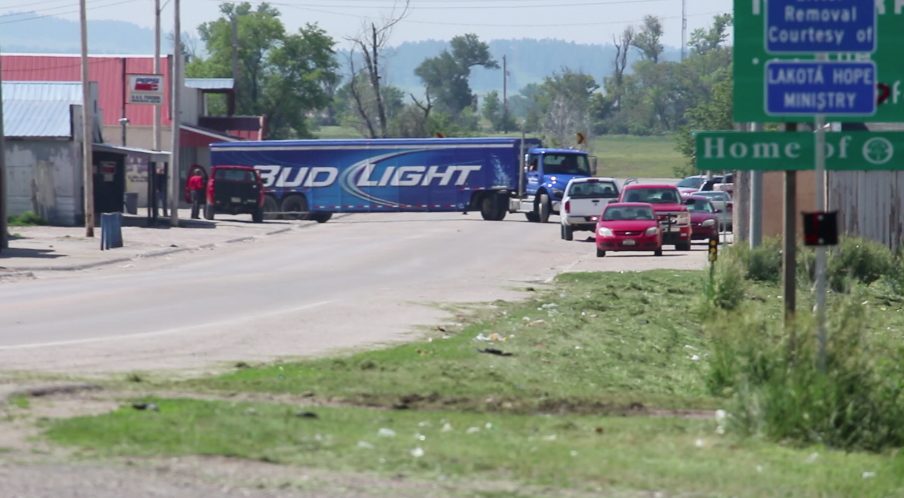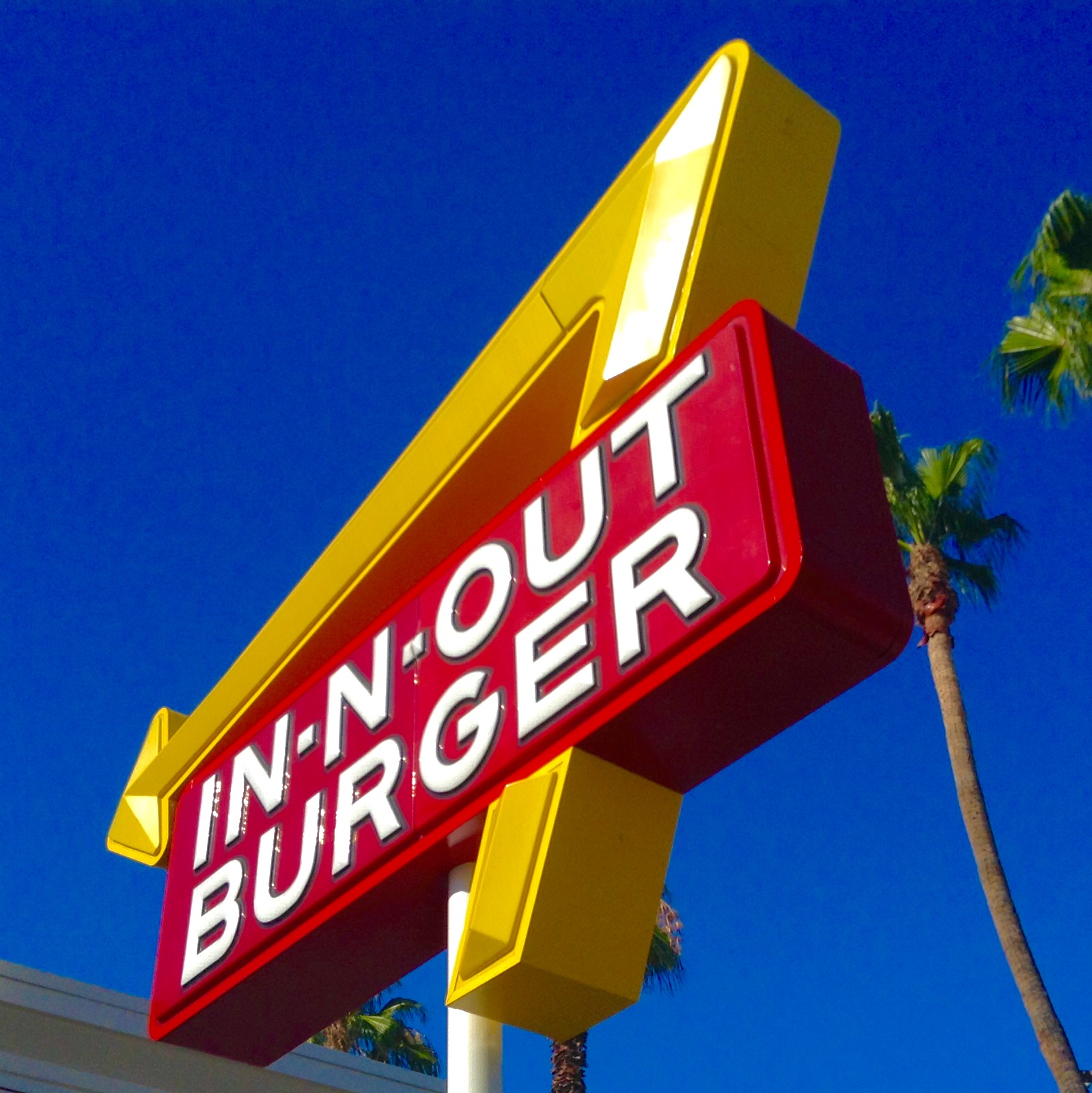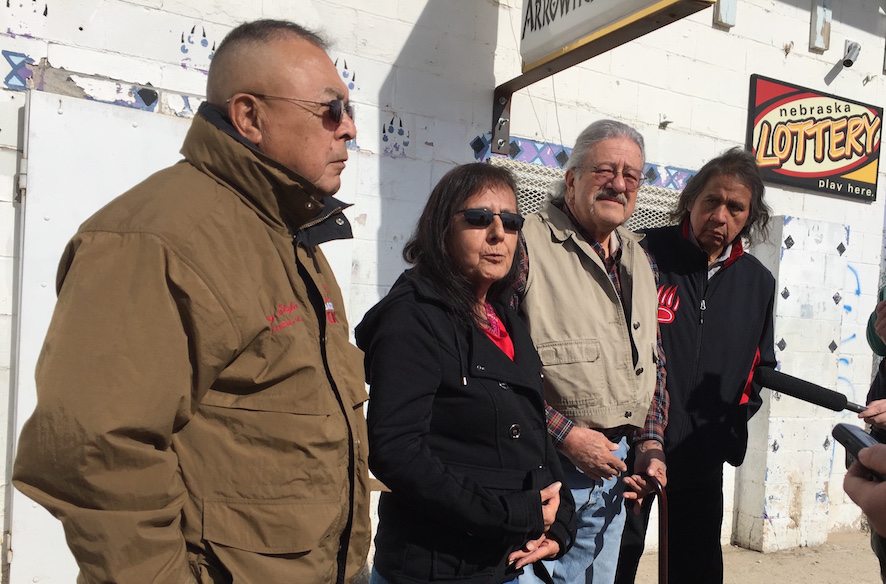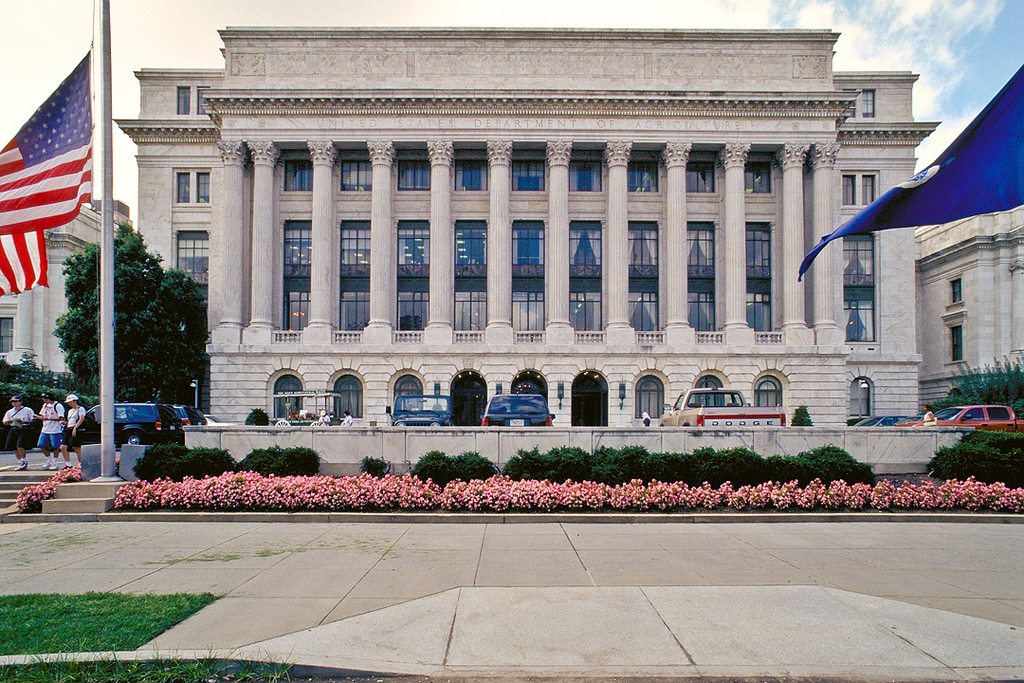
Jorge Castillo
In Lincoln, Nebraska last week, 150 people attended a 10-hour hearing that could decide the fate of a town with a population of less than 12.
Roughly 400 miles north, just off a lonely stretch of Highway 87, lies the locale in question: the unincorporated community of Whiteclay, Nebraska—home to four liquor stores that sell millions of cans of beer a year.
And less than two miles north of Whiteclay, across the state line in South Dakota, sits the Pine Ridge Indian Reservation, where one in four children are born with fetal alcohol syndrome. Inhabited by the Oglala Sioux Tribe, it’s the reservation’s residents that keep those four liquor stores in business. Roughly 40,000 people live on a nearly 3-million-acre expanse of grassy plain the size of Connecticut. More than half the population lives below the poverty line, unemployment hovers well above 80 percent, and life expectancy is the second-lowest in the western hemisphere, after Haiti.
Stemming the flow of alcohol is just one of the challenges facing this population. Last year, we reported on the tribe’s efforts to secure food sovereignty and take control over processing the herd of wild Lakota buffalo it harvests on its land each year.
Except for a brief period in the 1970s, alcohol has not been allowed on the reservation since 1832. But advocates say that at least two-thirds of its population struggles with alcoholism.
Proximity, it seems, breeds more than familiarity. In the case of Whiteclay and the Pine Ridge reservation, it also breeds despair: As a result of the alcohol sales, Whiteclay has become a town some Pine Ridge residents refer to as “our Skid Row.” Tribe members drive there to purchase beer and sometimes end up sleeping outside the liquor stores. The alcohol makes its way back onto the reservation, too. One Pine Ridge activist told me about driving with her uncle on a bootlegging mission to Whiteclay and paying cash for slabs of high-gravity Hurricane malt liquor, which her uncle then sold at a profit of $1 per can back on the reservation. Pine Ridge authorities say as much as 90 percent of the crimes they prosecute are alcohol-related.
 Google Maps
Google Maps Whiteclay is located less than two miles south of the Pine Ridge Reservation across the South Dakota-Nebraska border
Though advocates acknowledge that shutting down the flow of alcohol from Whiteclay wouldn’t solve the whole problem, they think stemming it is the first step toward recovery. And they say that, unlike other towns that border the reservation in South Dakota, this Nebraska town doesn’t play by the rules. “What we’re dealing with is criminal enterprise in Whiteclay. We’re not dealing with regular stores. We’re dealing with a small cartel that is resorting to violence and criminal activity to profit,” says Jorge Castillo, advocacy director for Alcohol Justice, a national industry watchdog group that has been involved in the issue for about four years.
For decades, activists have been trying to close—or at least get help to regulate—Whiteclay’s four liquor stores, sometimes staging rallies that block the road between the reservation and the town in an effort to raise awareness. The Oglala Sioux Tribe filed a federal lawsuit against the stores and major beer suppliers including Anheuser-Busch in 2012, but the case was dismissed in October of the same year.
The following year, in 2013, the tribe considered legalizing alcohol on the reservation, a change that would’ve given tribal leaders a measure of control over alcohol distribution and a share of the profits. A general vote turned out in favor of legalization, 52 to 48 percent, but the results were contested and the nineteen tribal council members did not move forward.
Above, graffiti on a building in Whiteclay. Use the navigation arrows to view more of the town.
So far, none of the efforts to shut down or regulate Whiteclay’s liquor stores have proved successful.
It is important to make a distinction here. A South Dakota tribe doesn’t have a whole lot of legal recourse over a town in Nebraska. Because the liquor stores are located across the state line from the Pine Ridge, South Dakota authorities can’t intervene on the tribe’s behalf.
But over the last two months, the legal tides may have finally started to turn: The Nebraska Attorney General’s office in March filed 22 citations against the four Whiteclay stores, including charges of selling to bootleggers and selling after hours. The same month, Senators Patty Pansing Brooks (D-NE) and Tom Brewer (R-NE) received unanimous legislative support in a first-round vote to authorize the formation of a Whiteclay task force. Local Whiteclay pastor Bruce BonFleur is considering buying the liquor stores outright just to shut them down. He’s talked with their owners, who have indicated they’d be willing to sell at a price just north of $6 million. (Whether that sum is one a local pastor could ever hope to raise seems dubious at best. But perhaps the more important question is whether or not the sale would prevent the owners from simply setting up another shop right down the road.)
And on April 7, the Nebraska Liquor Control Commission held a hearing to decide whether or not Whiteclay had an adequate police presence to continue selling alcohol.
A little background on this potentially promising development: in order to sell alcohol in Nebraska, a town has to have adequate law enforcement. That rule is open to interpretation, but it basically means there are enough police officers around to enforce alcohol-related laws and deal with the problems alcohol tends to cause, like drunk driving.
Activists contend that police officers can’t get to Whiteclay in a timely manner, since the town of Rushville, where they’re headquartered, is more than 20 miles away. They claim the lack of law enforcement emboldens liquor stores to flaunt regulations and creates an undisciplined environment. “As for the violence, it’s a daily thing, a continual thing,” says tribe member Kathryn Thunder Hawk.
But this recent scrutiny of the county’s law enforcement wasn’t sparked by activists. In fact, the impetus came from a statement by County Commissioner Jack Anderson, who in 2016 told a legislative committee that Sheridan County, where Whiteclay is located, “absolutely” doesn’t provide enough law enforcement to the border town. (He later walked back his statement, saying what he meant was that county taxpayers shouldn’t have to pay for a larger police force.)
 Jorge Castillo
Jorge Castillo That statement led the state liquor control commission to order the Whiteclay stores to reapply for their liquor licenses, which expire at the end of this month. The licenses were originally set to renew automatically.
So the Sheridan County Board—yep, that includes the commissioner who said there “absolutely” wasn’t enough police presence in the first place—in January heard four hours of testimony to rule on this question of adequate enforcement. The three board members deliberated for ten minutes and voted unanimously to maintain the status quo—that is, to reissue the four liquor licenses according to plan.
After the Sheridan Board hearing, the case proceeded to the Nebraska Liquor Control Commission, which brings us back to the present.
I spoke with Oglala Sioux activists as well as with Jorge Castillo, as they all were traveling to last week’s hearing. The mood was cautiously optimistic. No one felt like a Whiteclay shutdown would fix the alcohol problem on the Pine Ridge Reservation, but they did feel it would improve things. “We don’t want to fight our own people, so we’ve got to find solutions here,” Thunder Hawk said. “And one of the solutions is to get rid of Whiteclay. Or at least have the world see what Whiteclay is. We’re not a big town, but it’s our Skid Row. It’s our Skid Row, and we don’t want it here no more.”
Faith Fast Wolf, another activist along for the ride, pointed out that, while other reservation-adjacent towns in South Dakota also sell alcohol, they follow state regulations and their police forces collaborate with tribal authorities. Thunder Hawk added that Whiteclay “isn’t just a tribal problem, it’s Nebraska’s problem.”
Still, the activists are not convinced the Nebraska Liquor Control Commission will rule in their favor. “I can’t really trust the government,” Fast Wolf admitted. “But I really want to put trust into this.”
 Jorge Castillo
Jorge Castillo Organizers set up a “Zero Tolerance Camp” in Whiteclay in 2013
Castillo anticipated the thrust of their opponent’s case: “The other side says it’s personal responsibility and people are going to drink anyway. They always use that argument, but the activists are saying, ‘Look, you take care of your problem in Nebraska, stop illegal activity and the criminal activity by the stores, and we’ll take care of Pine Ridge.’ They want Nebraska to apply the law equally and fairly.”
The office of Andrew Snyder, the attorney for the defendants did not reply to request for comment.
Last Thursday’s hearing opened with testimony from Tatewin Means, Attorney General for the Oglala Sioux and the only licensed attorney in her 25-person office, which prosecutes 4,500 criminal cases per year. Means said she “can’t intervene and help our tribal residents, our families,” adding that she believes sexual assaults, physical assaults, and murders take place in Whiteclay, which is outside of her jurisdiction.
But representatives from the state of Nebraska and Sheridan County contended that law enforcement in Whiteclay is adequate, even without assistance from Pine Ridge police.
Major Kyle Otte of the Nebraska State Patrol pointed to a six-week period in which officers issued eight open container violations, five violations for drinking on public property, five DUI arrests, seven drug violations, 12 suspended drivers’ licenses, and two concealed weapons. In 2016, state officers increased their presence in Whiteclay by more than 40 percent (or a little over a hundred hours) over the yearly average, partially due to a state highway safety grant.
The most contentious part of the hearing came during Sheridan County Sheriff Terry Robbins’ testimony. Robbins submitted a log of the hours his deputies spent in Whiteclay, which showed that they averaged about 20 hours per week in the town. Attorney Dave Domina questioned the validity of that log.
“Is it your testimony that your people are in Whiteclay every night?” Domina asked.
“I didn’t say every night,” Robbins answered.
“Are they there three nights a week?”
 Jorge Castillo
Jorge Castillo Activists block the road in Whiteclay in 2013
At that point, Snyder, who represents the liquor stores, objected. Domina went on to cast more doubt: The log didn’t keep track of which deputies were where, he said, and whether or not they interacted with anyone in Whiteclay. He argued that the log was inconsistent with the electronic record of 911 calls and reports. “Why did you make another log? You’ve got an electronic dispatch record,” he said.
Robbins did not answer Domina’s question directly and did not respond to a request for further comment.
All four liquor store owners testified that they believed law enforcement from Sheridan County and the State Patrol was adequate. All four claimed that they followed the state liquor laws. Snyder pointed out the Nebraska has no laws against public intoxication, begging, or vagrancy.
But Whiteclay residents Abram Neumann and pastor Bruce BonFleur and his wife, Marsha, all testified that the police weren’t present enough.
“I observed, as I do every day, many people on the streets with open containers, many drinking,” Neumann said, adding that he once called 911 when he witnessed a diabetic seizure and didn’t see a timely response. “The times that I have called the police, they have done nothing to resolve the problems.”
Marsha Bonfleur added that the streets of Whiteclay are sometimes violent. “I see people fighting on the main street in front of businesses. Many have knives. Some have guns.”
Bruce Bonfleur didn’t mince words when asked outright if he felt law enforcement in Whiteclay was adequate: “No, emphatically.”
 Jorge Castillo
Jorge Castillo Abram Neumann testifies at the April 7 hearing
But James Jones, speaking on behalf of the plaintiffs as president of the National Liquor Law Enforcement Association, went a step further. Catching one of the liquor stores in a specific violation, he said, or proving police spend a certain number of hours per week in Whiteclay, misses the point.
“The effect an establishment has on a community goes well beyond what occurs on a licensed premise,” he said. “In many jurisdictions, the effects on the community are taken into account by enforcement personnel, as far as the identification of ‘problem establishments’ and the action we take.”
The Liquor Control Commission said it will release its decision by May 2. In the meantime, a separate hearing will be scheduled to address the citations the Nebraska attorney general’s office filed in March against the four liquor stores.
The most comprehensive plan for improving Nebraska’s side of the equation may be found in the hands of the previously mentioned proposal for a state senate task force—which is currently on the verge of unanimous approval. Its priorities include addressing fetal alcohol syndrome, access to treatment and detoxification facilities, and general economic development. Perhaps most importantly, it’ll look at funding models for accomplishing all of those goals.
No task force has ever been applauded for its swift results, and the road to recovery is never short. But even if the liquor stores remain open, the relationship between authorities in Nebraska and the Oglala Sioux in South Dakota may have reached a turning point.
This story was updated at 10:35 a.m. on April 12, 2017.










